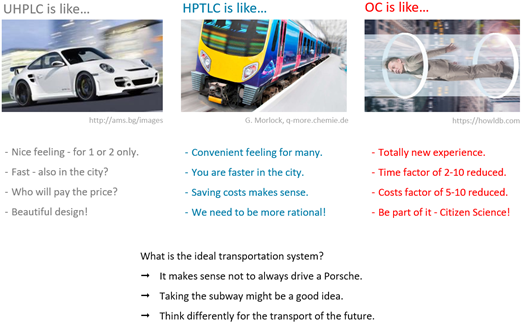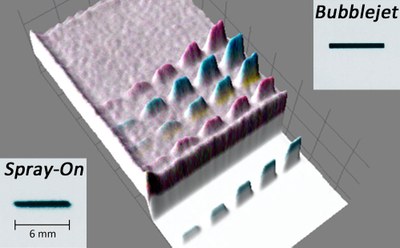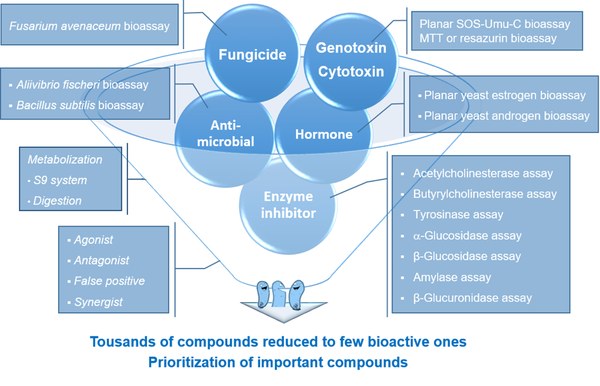Research
Our key drivers
-
"Qui veut faire quelque chose trouve un moyen, qui ne veut rien faire trouve une excuse."
Albert Camus, 1913-1960 - Be challenging in mind: think differently, yet mindfully and even disruptively to invent, challenge the status quo and push the boundaries of analytical thinking.
- Be inspiring in mind: analytical science is the basis of our knowledge; create sustainable and powerful analytical solutions making a difference.
- Be curious in mind: listen and observe to challenge your fantasy that drives your imagination and creativity.
- Be progressive in mind: change your perspectives and you will find a better way to solve it.
- Be beautiful in mind: leave it better than you found it!
- Trace analysis of functional food or health food, botanicals, environmental samples, pharmaceuticals etc.
- Pattern recognition and fingerprints
- Analysis of bioactive compounds (healthy compounds, but also toxins, active contaminants or residues etc.)
- Efficient effect-directed analysis combined with chromatography (HPTLC-EDA)
- Developement of straightforward validated methods for planar chromatography
- Miniaturization of analytical workflows
- Open source-based, all-in-one planar chromatographic system development (Office Chromatography)
- 2LabsToGo system
- Hyphenated techniques like HPTLC-UV/Vis/FLD-EDA-HRMS
- Open source-based automatization of interfaces for mass spectrometry
- Quantitative surface scanning by desorption-based mass spectrometry (DART-MS)
More than ever, consumers are getting concerned about the food or food supplements they consume. Botanical extracts play an important role in commercial food products with increasing tendency, though frauds are quite common. Food control, specifications and regulation need to be re-evaluated, as food contains thousands of different, mostly unknown compounds. Product changes are not only caused by natural variances or processing but also by residues and contaminations along the global product chain by addition of illicit compounds or adulterations.
Except for a minor portion of known bioactive compounds in a food sample, it is hardly known which of the other thousands of compounds are bioactive. Also we know that trace amounts do matter and show effects, as it is for hormones to mention one. Small changes do matter, if active components at the trace level have impact on the consumer`s health, especially when consumed regularly. Which analytical effort is rational? Which non-target method can point to relevant effects? Are all the thousands of compounds in a botanical extract under control? Which instrumentation is affordable?
An analytical technique that could cope with this complex task should be matrix-tolerant and thus avoid a discrimination of incredients by extended sample preparation steps. As we only see what is detectable with the given detection system, different detection principles are a must. So far, chemical marker compounds have been used to evaluate the product quality. How can these few marker compounds represent the whole sample complexity, including its activity?
“…we know there are known knowns.
These are things we know that we know.
We also know that there are known unknowns.
That is to say, there are things that we know we do not know.
But there are also unknown unknowns –
the ones we do not know we do not know…”
D. Rumsfeld, 2002
How to analyze unknown unknowns?
How to contribute to this daunting challenge? Let us try the impossible! Let us develop straightforward image-based bioanalytical hyphenated techniques and methods that can deal with the unknown unknowns.
Why not including bioprofiling or effect-directed fingerprints in routine quality control to ensure the product quality and food safety more comprehensively? By this, food fraud and food adulteration will easier be detected. Such bioanalytical techniques for bioprofiling are also able to detect the active principle of health food, functional food, traditional medicines, plant extracts etc.
Besides, we focus on miniaturization and think differently! By using totally new technologies in the field of chromatography, we try to set new perspectives and impulses: all-in-one 2LabsToGo system, Office Chromatography, open source technologies, pattern recognition algorithms, image evaluation by artificial neural networks, quantitative surface scanning using direct analysis in real time mass spectrometry (DART-MS), etc.
Konfuzius wisely said "Reaching the water source, you have to swim against mainstream". This is particularly true for planar chromatography. Still a decade ago, a handful of colleagues recommended me to change my subject - a well-meant advice for my academic career. But I believed in the power of this underestimated technique.
For teaching in the time of ultrarapid separations, I developed a metaphor in 2005:

No styling is needed if you go by metro, meaning raw extracts are transported in HPTLC!
Imagine any metropolis like New York, Beijing, Tokyo, Paris or Moscow without the metro?
What about separation science? No metro/subway needed... really?
Not needed although the eco-friendliness of HPTLC is as good as taking the metro?
The following figure also helps to understand that HPTLC is a niche in research and not seen as an option. This is caused by the fact that HPTLC is not trained in Analytical Chemistry or Food Chemistry (only the simple TLC as anti-proof that it makes no sense). The real potential of HPTLC is rarely known by the experts and accordingly often ends in structurally supported inefficiency.
We curiously focussed our research on aspects of HPTLC that are unique like...
- Spotlight on the zone! Targeted mass spectrometry avoids waste data or MS system contamination!
Since 2004, we have investigated the elution head-based coupling of planar chromatography with mass spectrometry. Since 2005, we have investigated desorption-based couplings as well. Up to now, we made over 100 peer-reviewed research papers that proved the progress in and benefit of the HPTLC-MS coupling, essential for the progress of HPTLC.
Thank is owed to the Landesstiftung Baden-Württemberg for funding a PhD position 2006-2009 and DFG/JLU for funding the high-resolution mass spectrometry system. - Microorganisms and adherent cells on the plate! The open format is suited best among all chromatographic techniques to be hyphenated with biological tools! Though our first papers were made in 2008, we mainly started with the development of quantitative bioautography in 2013. In 2014, sharply bounded active zones were reported for the first time after 70 years (in 1946, a Nature paper reported first on direct bioautography). New knowledge is obtained with this quantitative bioanalytical tool: We can deal with the unknown unknowns! We discover traces that matter. Our food is our medicine (attributed to Hippocrates) - so true! In over 50 peer-reviewed research papers, we brought forward this idea.
Thank is owed to Merck that instantly recognized the potential. Thank is also owed to DFG who granted a postdoc position, though the position was not fulfilled. - Print on the plate like on paper! This means be disruptive and think differently. Miniaturization to a still managable size is the key for progress. We showed printing on the plate for the first time in 2007. We developed it further and printed sample solutions, the mobile phase or the HPTLC layer itsself. The current state is an open source Office Chromatography (OC) system.
The exploited open source technologies also offered potential for own tailormade automatizations with regard to automated HPTLC-MS, for which we submitted 2 papers.
Since I went back to academia in 2004, I noticed the beauty in the valleys passed - success is a journey. Crises are opportunities and chances to grow. Meanwhile, we made over 950 scientific contributions, including more than 70 practical workshops, to give HPTLC an independent voice, trained and inspired more than a hundred guest researchers from over 25 countries in the potential of HPTLC, solved severe challenges of industrial processes and do have many requests from and projects with other academic groups and industries.
2LabsToGo
Why not? The miniaturized all-in-one open source system!
In 2010, we have founded a new discipline combining planar chromatography with office peripherals, called Office Chromatography. Focussing the open planar concept and participating in the worldwide progress of print & media technology, office chromatography will provide an ideal platform for miniaturized planar chromatography on credit-card-sized ultrathin layers. Chromatographic runs are performed within a minute for many samples in parallel, meaning runs/sample below a second in a user-friendly and eco-friendly environment. This new discipline is highly disruptive. The sustainable, portable, open-source 2LabsToGo system combines a chemical-analytical laboratory with a biological laboratory; it combines sample separation with biological effects detection and provides a solution for checking the quality of complex samples. Sustainability is guaranteed by low manufacturing and operating costs; analyses can be performed anywhere in a user- and environmentally-friendly environment, also supported by solar energy. The sustainable 2LabsToGo concept is especially useful for all laboratories with limited space and budget, but urgent analytical challenges. Read more in a review as well as OCLab1, OCLab2 ... OCLab3 was published in 2022 as 2LabsToGo system! Here the Link to the open-source platform for file download.
Effect-directed analysis
Better glasses needed? You want to see more?
HPTLC-EDA-HRMS as quantitative bioanalytical tool that points to effects
HPTLC coupled with bioactivity-based detection by Aliivibrio fischeri and Bacillus subtilis bacteria or genetically modified yeast strains (pYES/pYAS assays, including antagonistic effect detection pYEAS/pYAAS assays) or enzymatic detections is combined with high resolution mass spectrometry (HRMS). On the example of screening for bioactive natural products in marine sponges this effective analytical approach was demonstrated via HPTLC-UV/Vis/FLD-bioactivity-HRMS (6, Chinese). All the following information was reached by a single HPTLC separation: (I) up to 30 sponges (just lyophilized, dissolved and centrifuged) were screened matrix-robust at one go for natural bioactive secondary products (UV/Vis/FLD/EDA images), (II) high producers of bioactive products were identified, (III) information on the range of bioactive products produced by the sponge was given and (IV) the sum formula was obtained from bioactive zones of interest. Read more in an original research paper or in the latest review.

Hyphenation HPTLC-MS
Targeted and fast. Say NO to data recording of matrix and background or unnecessary MS system contaminations!
In my professorial thesis research, I successfully focussed on hyphenations and particularly on coupling of HPTLC with mass spectrometry (HPTLC-MS) because there has not been available any rational and practical coupling technique. A key feature of HPTLC-MS is the cost-effective, targeted recording of mass spectra. Different approaches were investigated via open ionization sources working under ambient pressure. Direct analysis in real time (DART) was first coupled to planar chromatography (5) as well as atmospheric pressure glow discharge (APGD, later called FAPA). Meanwhile optimized solutions are existent. We substantially modified the DART SVPA interface and achieved mass signals that were by a factor of 34 more intense. Our modifications also enable a quantitative surface scanning, not only on TLC/HPTLC plates. We also helped to adapt the protocol for TLC-matrix-assisted laser desorption & ionization (MALDI). Using this technqiue, HPTLC-MALDI-TOFMS achieved repeatabilites of about 10 % directly from the plate via Imaging MS. In April 2004, Dr. Luftmann from University of Münster published a paper on a TLC-MS interface. One month later, I was visiting him, as I was excited to get such an interface. He was very very happy and surprised at the same time, as he had approached all companies in the field several times over 3 years - but he faced always no interest of the companies! At that time the interface worked only on flexible TLC foils/carriers, and we modified it for its usage on TLC/HPTLC glass plates first. Then, we showed that, using this modified interface, detectabilities were comparable to HPLC-MS and a reliable quantification was possible, too. By our research reported in over 15 original research papers, we pointed out that the modified interface was the most reliable and universal plug & play tool for HPTLC-MS coupling worldwide. After four years (!), a company took over this successful approach in 2008 and started marketing of the interface in spring 2009 (flyer TLC-MS Interface). Nowadays several options are available for recording of mass spectra of zones of interest from the HPTLC plate within seconds. Read more in the latest original research paper and review...
Streamlined analysis
One can do it the way around or straigthforward - your decision. Who pays for inefficiency?
Planar chromatography comprises all chromatographic techniques, which have an open planar stationary phase present as or on a plane. Therein, the simple thin-layer chromatography (TLC) is the widest spread chromatographic technique; whereas high-performance TLC (HPTLC) is considered as the most efficient and powerful planar chromatographic technique standing for optimized coating material (lower particle size and narrower particle size distribution) in combination with the employment of advanced instrumentation for mostly all steps of the chromatographic process. HPTLC was turned out to be of high relevance in the age of ultra rapid separations because the planar format offers unrivalled features. A 1000 matrix-robust sample runs per 8h-day are readily reached by HPTLC. This was shown for quantitative analysis of sucalose in milk confect and dietary food (1) or for water-soluble food dyes in various food (2). Method development and sample throughput is very fast using HPTLC. This was shown for isopropylthioxanthone, a new contaminant found in milk, for which the newly developed HPTLC method was published first (3). Also difficult analyses can be performed by HPTLC like shown for heterocyclic aromatic amines or acrylamide in drinking water (4), potatoe chips and coffee leading to comparable results as obtained by HPLC. Further rapid screening is shown for PAH analysis in water samples, additives in mineral oils with hyphenation of HPTLC with ATR-FTIR or explosives. Read a recent paper on such a streamlined method...
"Nichts setzt dem Fortgang der Wissenschaft mehr Hindernis entgegen, als wenn man zu wissen glaubt, was man noch nicht weiß."
G. C. Lichtenberg, 1742-1799







